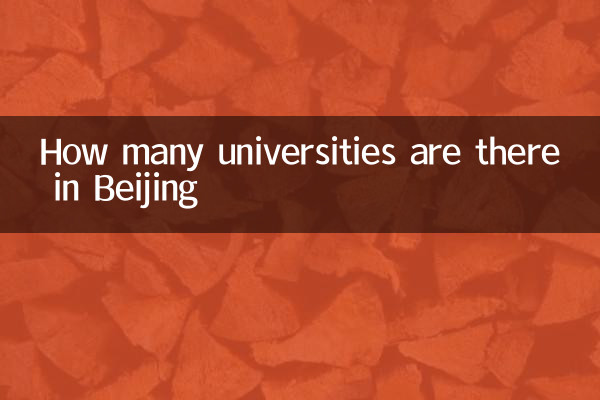How many universities are there in Beijing? Revealing the distribution of colleges and universities in China's higher education centers
As China's political, cultural and educational center, Beijing has the most intensive higher education resources in the country. Whether it is a top "Double First-Class" university or a college with distinctive characteristics, Beijing can be regarded as a benchmark city for China's higher education. This article will combine popular educational topics across the network for nearly 10 days to present detailed data from Beijing universities in a structured manner.
1. Panoramic overview of the number of universities in Beijing

According to the latest data from the Ministry of Education and hotly discussed content on various platforms, the number of universities in Beijing shows the following characteristics:
| category | quantity | Percentage |
|---|---|---|
| Undergraduate School | 67 | 58% |
| Colleges and universities | 25 | twenty two% |
| Independent College | 5 | 4% |
| Military Academy | 6 | 5% |
| Adult colleges and universities | 12 | 11% |
| total | 115 | 100% |
2. Distribution characteristics of colleges and universities
In recent education topics, the discussion on "Double First-Class" construction universities has continued to rise. As a gathering place for high-quality higher education resources, Beijing's colleges and universities are distributed as follows:
| School Type | quantity | Representative schools |
|---|---|---|
| Double First Class Class A | 8 | Peking University, Tsinghua University, Renmin University, etc. |
| Double first-class Class B | 1 | Central University for Nationalities |
| First-class discipline construction universities | 27 | Beijing Jiaotong University, Beijing University of Science and Technology, etc. |
| General undergraduate colleges | 31 | Beijing United University, etc. |
| Higher Vocational (Junior) Colleges | 25 | Beijing Electronics Vocational College, etc. |
3. Regional distribution hot spot analysis
In light of recent hot topics such as "Beijing University Relocation" and other hot topics, Haidian District is still the most densely populated area for colleges and universities:
| Administrative Region | Number of colleges and universities | Density index |
|---|---|---|
| Haidian District | 38 | ★★★★★ |
| Chaoyang District | 18 | ★★★ |
| Changping District | 15 | ★★★ |
| Fengtai District | 9 | ★★ |
| Other areas | 35 | Dispersed distribution |
4. Classification and inventory of special colleges
The types of special colleges and universities that have been hotly discussed on social platforms recently include:
| School Category | quantity | Typical representatives |
|---|---|---|
| Art schools | 8 | Central Academy of Fine Arts, Central Academy of Arts |
| Sports colleges | 2 | Beijing Sports University |
| Language schools | 5 | Beijing Foreign Studies University |
| Ethnic colleges and universities | 1 | Central University for Nationalities |
| Police colleges | 3 | People's Public Security University of China |
5. Perspective of the scale of college students
According to the latest statistics and hot topics of online discussion, the scale of students in Beijing universities shows the following characteristics:
| Student Type | Number of people (approximately) | Percentage |
|---|---|---|
| undergrad | 580,000 people | 62% |
| Master's degree student | 220,000 people | twenty four% |
| Doctoral student | 80,000 people | 9% |
| International students | 50,000 people | 5% |
| total | 930,000 people | 100% |
6. Latest development trends in colleges and universities
In light of the education hotspots in the past 10 days, the construction of Beijing universities has shown three major trends:
1.The construction of new campus is accelerating: Many universities have set up branches in Xiongan New Area, and the construction of projects such as Tsinghua University Tongzhou Campus and Renmin University of China Tongzhou Campus have caused heated discussions
2.Interdisciplinary integration: Emerging interdisciplinary disciplines such as artificial intelligence and digital economy have become the focus of college construction, and new related majors such as Peking University and Tsinghua University have a high degree of discussion.
3.International exchanges restart: With the recovery of international exchanges after the epidemic, the adjustment of the admission policy for international students in colleges and universities has become the focus of attention
Conclusion:
As a highland of higher education in China, Beijing's 115 universities constitute a complete higher education system with a rich range of levels. From the data, it can be seen that Beijing not only has the country's top research universities, but also a large number of applied universities and characteristic colleges, forming a unique higher education ecosystem. With the advancement of the coordinated development strategy of Beijing-Tianjin-Hebei and the deepening of the construction of "Double First-Class", the layout and development of Beijing universities will continue to attract widespread attention.

check the details

check the details